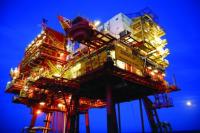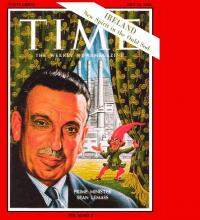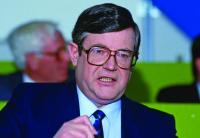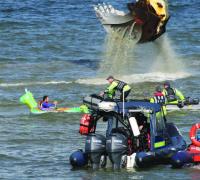Sale of the century:the £500 deal for Ireland’s gas and oil
Published in 20th-century / Contemporary History, Features, Issue 4 (July/August 2011), Volume 19
Production platform of Kinsale Energy, formerly Marathon Oil. In 1973 Marathon confirmed that it had found commercially viable quantities of natural gas off the Old Head of Kinsale, Co. Cork. According to Dr Seán O’Connell (April 1974), ‘the concessions given to the Marathon Oil Company were being constantly referred to in trade and scientific magazines as amazing, exceptional’. (Kinsale Energy)
In March 1958 an oil company was registered in Dublin with a view to securing exploration rights for the 27,000 square miles of the Irish Republic. The principal shareholders were George Collins, Roger Messman and Charles Rinehart. All three were from America and each held a £1 share in the company, which they called Madonna Oil. Nine months later they were granted exclusive exploration drilling rights by the minister for industry and commerce, Seán Lemass, for the sum of £500. In 1961 a two-thirds share in those rights was sold for $450,000. Over the course of the next ten years the lease changed owners and was reduced in size, but by 1975, following the discovery of gas off the coast of Kinsale, Co. Cork, the lease was valued at £31 million.
The move to secure exploration rights was in line with similar moves across Europe. The post-war years saw an expansion in the search for gas, oil and mineral resources. Although Britain had discovered its first oilfield in 1919, its first commercial oil well was not opened until 1939, when production began at a site just outside Eakring in Nottinghamshire. By 1944 there were around 100 oil wells in the vicinity. In 1953 the British Gas Council announced a £1 million, five-year exploration plan. France soon undertook a similar survey, spending over 600 million francs in the search for fossil fuel resources within its borders. In July 1959 huge reserves of gas were discovered in the province of Groningen in the Netherlands. Twelve years before, the largest onshore oilfield in Europe had been found just outside the town of Schoonebeek to the north-east of the country.

Seán Lemass—in late 1958, as minister for industry and commerce, he granted exclusive oil exploration drilling rights for the sum of £500. (Time)
Ireland ‘open for business’
The possibility of oil and gas reserves in Ireland was raised in 1955 by W.D. Gill, professor of geology at Trinity College, Dublin. He had undertaken a survey of west Clare and found that the county’s rock structures were similar to those in Nottinghamshire. ‘I am absolutely convinced that West Clare deserves attention’, he told the Irish Times, ‘and no doubt will eventually receive it.’ The Irish government at this time was actively encouraging foreign investment, especially with regard to the development of the country’s mineral resources. In November 1955 the head of the Irish Development Authority, Dr James Beddy, said in Bonn, Germany, that Ireland ‘was interested in the establishment of any and every industry’. He told a reporter that ‘many towns, particularly in the West of Ireland, were willing to supply new industries with free building sites and grant them 33 per cent exemptions from rates for seven years’. At a meeting of the Boston Chamber of Commerce in January 1956, William Norton said that Ireland had ‘an intelligent and adaptable labour supply, an advantageous position for international trade, generous tax and import regulations designed to stimulate industry, easy conversion of Irish earnings into dollars, and stable political and economic conditions’.
The Americans who came to Ireland in March 1958 were representatives of the Messman–Rinehart Oil Company of Wichita and the Ambassador Oil Corporation of Forth Worth, Texas. Sometime after their arrival, they hired Arthur Cox and Co. of St Stephen’s Green, Dublin, as their legal advisers. Contact was made with the Department of Industry and Commerce and negotiations were opened up. They also changed the company’s name to Ambassador Irish Oil. In October 1958 the Department of Industry and Commerce said that ‘substantial progress’ had been made in discussions with Ambassador. Three months later, Lemass told the Dáil that a formal agreement had been signed which gave Ambassador exclusive exploration rights to Ireland’s territory. When asked whether the deal gave the company the right to explore Ireland’s offshore territories, Lemass replied that he could not be expected to answer that question ‘off the cuff’ and that it would take a good fifteen minutes to explain the deal to the Dáil. Subsequent events showed that the company had indeed been granted those rights. In 1961 Ambassador sold two-thirds of the lease to Continental Oil and Ohio Oil International for a total sum of $450,000. At this stage the original shareholders were no longer listed on the board of directors. In their place appeared the solicitor Arthur Cox and his partner in the firm, Daniel Joseph O’Connor.

Ray Burke—in 1989, as minister for energy, he reduced the state’s 50% share in its offshore oil and gas to zero; he also abolished royalties. (Victor Patterson)
Kinsale gasfield
Six onshore dry wells were drilled in Ireland between August 1962 and September 1963 before Continental Oil cut its losses and sold its share to Ohio Oil, which had recently changed its name to Marathon. Ambassador Oil, which had subsumed the share in the lease previously held by its Irish subsidiary, did the same. In 1965 Marathon began a two-year offshore exploration of Ireland’s coastline, without success. Marathon then approached the government and asked it to ratify the Geneva Convention, which allowed countries to claim jurisdiction on the ocean floor up to a depth of 200m. The government did this, but took the opportunity to renegotiate the terms of the original lease. Marathon was allowed to keep one thirdof Ireland’s oil and gas rights, but it got to choose which area it kept and which it gave back. It kept the southern box, and in 1973 Marathon confirmed that it had found commercially viable quantities of naturalgas off the Old Head of Kinsale, Co. Cork. It then set about selling the gas back to Ireland at a cost, which was estimated in 1977 to be £700 million.
The renegotiation of oil and gas rights led to a fresh round of speculation. Between April 1971 and January 1974 the Irish government issued 59 non-exclusive petroleum-prospecting licences, which allowed the holders to search for petroleum and natural gas on the continental shelf surrounding the Republic. Each licence cost £610, which consisted of a £10 application fee, a £100 consideration fee and a £500 yearly rental fee. Of the 61 companies that held the licences in 1974 only eight were Irish. The majority of the survey and exploration work was undertaken by four companies who were themselves licence-holders: Western Geophysical, Delta Exploration, Continental Oil and CCG. They worked on a subcontracting basis and sold the results of their surveys to the licence-holders, who did not need to have any experience in oil and gas exploration in order to attain a licence. They merely needed to be ‘competent persons’ and have the necessary funds to ‘purchase the technical competence’ needed for exploration. Nor did the government require the licence-holders to actually explore for oil and gas. ‘It was possible’, wrote Paul Tansey in 1974, ‘to spend £610 on acquiring a licence, undertake no expensive exploration work and hope that the non-exclusive licence will provide a passport to securing an exclusive licence.’

Protester disrupting Shell dredging in Broadhaven Bay, Co. Mayo. (Simon Foster)
The price of the licence was highlighted by Dr Seán O’Connell, a lecturer in Edinburgh University, at a public meeting in Monaghan in April 1974:
‘It is maddening to see Britain selling off oil-blocks for exploration at figures of £1? million plus while one oil company held more than 100 such blocks belonging to Ireland. And it was almost ridiculous for a company which had got oil concessions from the Irish government to sell them to other companies.’
He told the audience that ‘the concessions given to the Marathon Oil Company were being constantly referred to in trade and scientific magazines as amazing, exceptional’. In 1977 the Resources Protection Group pointed out that the terms and conditions of the non-exclusive licences saw some Irish businessmen ‘set up front companies to give the impression of Irish involvement . . . [then] . . . without risking capital or having to prove technological expertise they carved a niche for themselves so that when it came time to allocate [exclusive] licences they were there to the fore’.
Speculation, rather than investment
This approach was akin to the property speculation booms of the 1960s, when large tracts of farmland surrounding Dublin and other cities were purchased and then parked until they were rezoned, transforming the property into significant payouts. By the 1970s, speculation, rather than investment in actual economic activity, was firmly established as the modus operandi of the Irish élite, while the Irish state was charged commercial rates for the use of its own resources. In 1989 the minister for energy, Ray Burke, reduced the state’s 50% share in its offshore oil and gas to zero. He also abolished royalties. It was under these terms that a frontier licence was awarded to explore the area off the north-west coast of Ireland in 1993. Three years later, large reserves of gas were found 80km from the Mayo coast, in what has become known as the Corrib gasfield. HI
Conor McCabe is a historian and journalist.
Further reading:
R. Allen & T. Jones, Guests of the nation: people of Ireland versus the multinationals (London, 1990).
D. Coughlan, ‘Saga of gas, oil lease sold by State in 1959 for £500’, Irish Times, 6 February 1974.
C. McCabe, Sins of the father: tracing the decisions that shaped the Irish economy (Dublin, 2011).
















